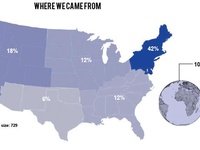• The next runner-up is the technology and engineering sector, which 13 percent of the employed members of the Class of 2013 will enter.
Asked what industry they would like to be working in ten years from now, students made very different choices.
• The consulting sector went from the very top choice to the very bottom. Just 1 percent see themselves as 32-year-old consultants.
• 5 percent said they still want to be working in finance.
• Health was by far the dominant field of choice in students’ 10-year plans, attracting 20 percent of students. Just 7 percent will enter the industry right away—the years it takes to get through medical school likely account for much of this difference.
• 11 percent would like to be working in arts, sports, or entertainment, though just 5 percent will start out there.
• 9 percent envision a career in government or politics, though only 4 percent will pursue one right away.
PAY DIRT
Salary, of course, plays a large role in determining students’ plans just out of college. The average employed graduate will make roughly $60,000 in his or her first year out of Harvard, according to the survey results. But salaries vary tremendously across industries.
• Among students working in consulting, the most popular field, 72 percent expect to earn between $70,000 and $90,000.
• In the nearly equally popular financial sector, salaries are even higher—a full 21 percent of students entering that field will earn more than $110,000 in their first year on the job.
• And technology can be still more lucrative—almost half of students entering the field will make $90,000 to $110,000 in their first year, and some will make even more.
• For the 12 percent of employed students who will work in education—largely thanks to the popularity of Teach for America—70 percent expect to make between $30,000 and $50,000. Another 15 percent will work for less than that, and 9 percent do not yet know their salaries. Only 6 percent expect to earn more than $50,000, and none more than $70,000.
Salary differs noticeably between male and female students. Men are much more likely to appear in the highest pay brackets than women: Of the students who expect to earn more than $110,000 in their first year of work, three-quarters are male. Of those who will earn $90,000 to $110,000, men represent nearly two thirds. And those numbers come from a pool of respondents which included more women than men, suggesting that the true tallies are in fact slightly more weighted in men’s favor.
The difference in industries chosen by male and female students partially accounts for the difference in pay. Men enter finance, consulting, and technology at higher rates than women, while more women pursue education, media, and health after college.
Read more in News
Magic, Magic, MagicRecommended Articles
-
Soaking Up Some Timeless Fen-RaysAppearances can be deceiving. I stretched my legs over recently emptied seats, eased my body backwards, tossed my face in
-
National SportsGRAPEFRUIT LEAGUE St. Louis (N) 000 030 011--5 10 0 Boston (N) 010 200 000--3 6 3 Cincinnati (N) 013 010 200--7 10 0 Philadelphia (N) 200 110 100--5 11 2 Detroit
-
 Rant: Filming on Campus
Rant: Filming on Campus -
 Eliot House
Eliot House -
 Base Salary
Base Salary














